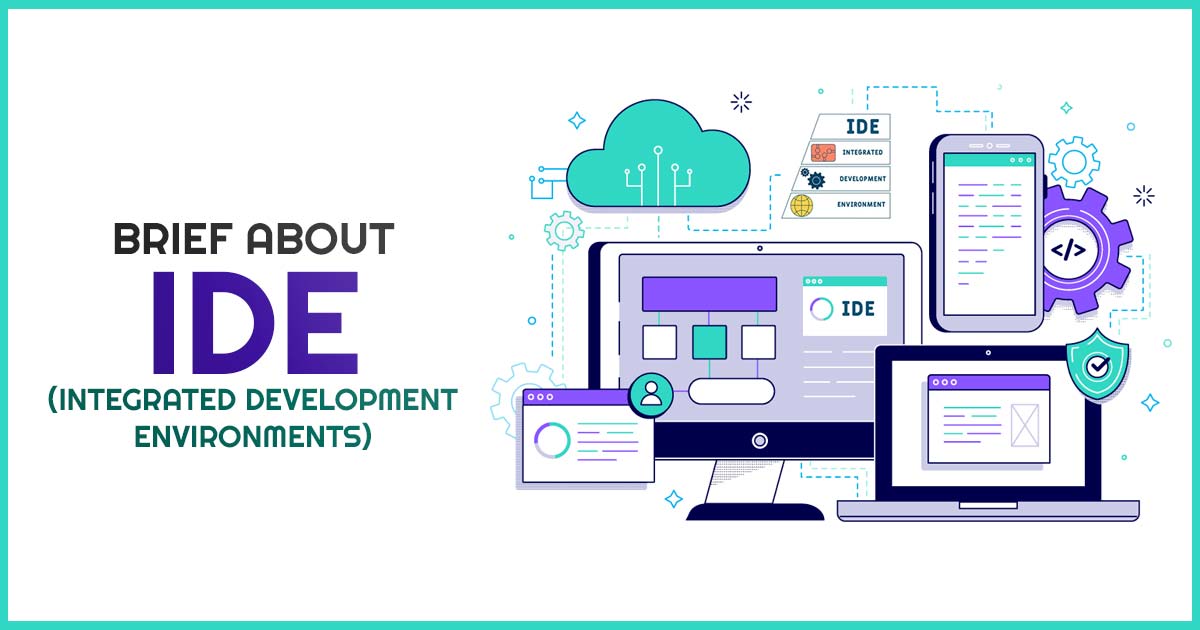
A software app known as an integrated development environment (IDE) offers complete features for software development. A source code editor, build automation tools, and a debugger is typically included in an IDE. The necessary compiler, interpreter, or both are included in some IDEs like NetBeans and Eclipse, but not in others like SharpDevelop and Lazarus.
The line separating an IDE from other components of the larger software development environment is not always clear; occasionally a version control system or different tools to make creating a graphical user interface (GUI) simpler are combined. For usage in object-oriented software development, many contemporary IDEs additionally include a class browser, an object browser, and a class hierarchy diagram.
An application named Integrated Development Environment furnishes web developers with the tools needed to develop the software. It consists of a text editor, automation tools, code compilation, and a debugger.
For supporting the programmers in developing the software, an integrated development environment (IDE) software furnishes the complete tools and features. Developers can write, debug, test, and release their code more quickly thanks to this centralized environment that unifies several software development tools into a single interface.
A few IDEs for web development do, however, provide the essential interpreter, compiler, or both.
Let’s examine some of the most popular IDE features for web development.
Introduction About Integrated Development Environments (IDE)
Apps called integrated development environments (IDEs) make it easier to create additional apps. An IDE’s core interface provides all the tools a developer needs and is designed to incorporate all programming jobs in a single application. These tools include:
- Editing Code: Designed specifically for the purpose of writing and editing source code, code editors stand apart from regular text editors by offering functionalities tailored to simplify or enhance the code development process for developers.
- Developing compilers: Compilers play a crucial role in converting human-readable or writable source code into a format that computers can understand and execute.
- Using the Debugger (Testing tool): Debuggers are indispensable tools used during the testing phase, assisting developers in identifying and resolving issues within their application programs.
- Build Automation & Developer TasksTools: Auto/These valuable tools automate repetitive developer tasks, streamlining workflows and saving significant amounts of time.
Moreover, certain IDEs might comprise-
- Class structure in the browser: The same would be utilized to study and reference the properties of the object-oriented class hierarchy.
- Object browser for validating Code: Used to validate the items created by an application program that is now executing.
- Class hierarchy and programming code diagram: This enables the developers to visualize the object-oriented programming code structure.
Read Also: A Quick Guide to Web Applications with Development Process
The IDE may be a standalone app, but it may also be a component of one or more other compatible apps.
What is the Use of an IDE for Developers?
Because several tools don’t need to be manually installed and integrated as part of the setup process, an IDE enables developers to begin developing new apps rapidly. Additionally, since every utility is available on the same workbench, developers don’t have to spend hours learning how to use each one separately.
When bringing on new developers, who may rely on an IDE to familiarise themselves with a team’s standard tools and procedures, this can be extremely helpful. In reality, the majority of IDE capabilities, such as intelligent code completion and automatic code creation, are designed to save time by eliminating the need to write out whole letter sequences.
Other popular IDE features are intended to assist developers in managing their workflow and issue-solving. IDEs parse code as it is written, identifying problems caused by a human mistake in real-time. Because utilities are represented by a single graphical user interface, developers may carry out activities without moving between apps.
Most IDEs also include syntax highlighting, which employs visual cues to make a difference in grammar in the text editor. Class and object browsers, including the class hierarchy diagrams for specific languages, are also included in several IDEs.
It is feasible to develop apps without using an IDE, or each developer can create their own IDE by manually combining numerous utilities with a lightweight text editor such as Vim or Emacs. This strategy’s advantage for certain developers is the extreme customization and control it provides. However, in a business setting, modern IDEs’ time savings, environment standardization, and automation features typically trump alternative factors.
Today, the decision is not whether to adopt an IDE, but rather which IDE to use as the majority of enterprise development teams choose a pre-configured IDE that is appropriate to their particular use case.
Main Advantages of Integrated Development Environments
Integrated development environments increase the productivity of developers. By reducing setup time, speeding up development chores, keeping developers informed of the most recent dangers and best practices, and standardizing the development process so that everyone can follow along, these IDEs increase productivity.
Streamlining the Setup Process:
Without an IDE interface, programmers must spend time configuring several development tools. Programmers can have the same set of skills in one place by integrating an IDE, eliminating the need to frequently switch tools.
Improved Development Speed:
The productivity of developers is increased by the tighter integration of development jobs. Developers may, for instance, parse code and verify syntax as they edit, providing real-time feedback when syntax problems are introduced.
To complete tasks, programmers no longer need to switch between apps. The tools and capabilities of the IDE also assist programmers with resource organization, error prevention, and shortcut implementation.
IDEs can assist in restructuring the development process by encouraging comprehensive planning for an even greater advantage. They encourage programmers to view their activities as part of the complete software development lifecycle (SDLC) rather than as a collection of discrete jobs.
Importance of Continuous Learning:
The capacity to keep informed and current is another advantage. An IDE, for instance, frequently adds fresh examples, project templates, and other content to its help sections. Developers are more likely to benefit their team and the company by adding value, which increases productivity if they are always learning and staying up to date on best practices.
Standardization Programmers:
Additionally, it controls the development process, enabling programmers to collaborate easily and helping new recruits get up to speed so they can start working right away.
All Types of IDEs Which Most Commonly Used
There are several proprietary and open-source IDE choices available because of the wide variety of technical and commercial use cases for IDEs. Typically, the key factors that set IDEs apart from one another are:
Multiple Languages Supported:
Certain IDEs are committed to one language, and so are a better match for a particular programming paradigm. IntelliJ, for example, is known primarily as a Java IDE. Other IDEs have a broad array of supported languages all in one, like the Eclipse IDE which supports Java, XML, Python, and others.
Supported iOS or Android Operating Systems:
An operating system of the developer will constrain which IDEs are feasible (unless an IDE is cloud-based), and if the application being developed is planned for an end user with a certain operating system (like Android or iOS) the same may be an additional constraint.
Automation Code and Debugger Tools:
Despite the majority of IDEs consisting of three major features of a text editor, build automation and debugger, others consist of support for other features such as refactoring, code search, and continuous integration and continuous deployment (CI/CD) tools.
Performance Impact on the System
When the developer wishes to run additional memory-intensive apps then IDE’s memory footprint might be crucial to acknowledge.
Plugins and Extensions of Software
Certain IDEs consist of the capability to customize the workflows to match the requirements and preferences of the developers.
Process of IDE for Android and iOS Mobile Development?
There would be IDEs that comprise PhoneGap and Titanium Mobile from Appcelerator, particularly for the development of the mobile.
There are various IDEs certainly multi-language IDEs, that have mobile-development plugins. For instance, Eclipse has this functionality.
Develop HTML IDE App platform
Some of the popular IDEs are those that are used to develop HTML apps. For instance, in the website development procedure DreamWeaver, HomeSite, and FrontPage automate multiple tasks.
Cloud-Based IDE Development Platform
Cloud-based IDEs are becoming increasingly popular and should be kept an eye on. Because the capabilities of such web-based IDEs are fast expanding, most major companies will almost certainly need to provide one if they wish to remain competitive in their markets. Cloud IDEs are useful because they allow programmers to access their code from any location.
Nitrous, for example, is a cloud-based development environment platform that supports Ruby, Python, Node.js, and other languages. More than 40 languages are supported by Cloud9 IDE, including PHP, Ruby, Python, JavaScript with Node.js, and Go. Heroku is a platform as a service (PaaS) for cloud-based development that supports a variety of programming languages.
SDMT Integrated Development Environments (IDE)
Unlock the power of efficient code generation and streamlined development with SDMT Integrated Development Environment (IDE). Our cutting-edge solutions revolutionize the coding phase, reducing it by up to 80% for applications. Empowering developers with an extensive range of tools and functionalities, our IDEs enhance productivity and foster collaboration like never before.
SDMT IDE allows you to access the advanced application development process. LCNC low-code and no-code platform is the future of hassle-free website creation and app development. Complex coding and time-consuming coding procedures cease your creativity to bring uniqueness to the final product. The platform’s low-code and no-code features and auto-code generation help developers shape their innovative ideas into the web development process quickly.









